Guernsey and Her Island Fiefs
One of the most enduring effects of Guernsey’s association with Normandy is the system of fiefs in the island. The island’s link with the Crown is feudal, as the Queen is still Duke of Normandy (… yes “Duke ” …see our article The Queen, Our Duke), and homage is due to her from the Seigneurs of the island fiefs. Many place-names perpetuate the link with the former Norman Seigneurs.
The Feudal System
The Norse conquerors of Normandy adopted the fief system as an effective method of organising the collection of revenue and the administration of justice in the conquered territory, which was divided up into areas known as “fiefs” among the Norman Knights who were known as ” Seigneurs”. In return for the revenue derived from the arable lands of their fiefs the Seigneurs had the duty of homage to the Duke, and of supplying armed horsemen for the ducal army; as a reward for undertaking these responsibilities the Seigneurs enjoyed the exclusive right of hunting on their fiefs, and the status symbol of a dove-cot, “colombier,” standing apart from their residence; inferior feudal grades were allowed a “tourelle” attached to their house, while still lower grades had to be content with pigeon-holes cut in the gables. In addition, the Seigneur owned the mill or mills on his fief to which his tenants were compelled to bring their corn.
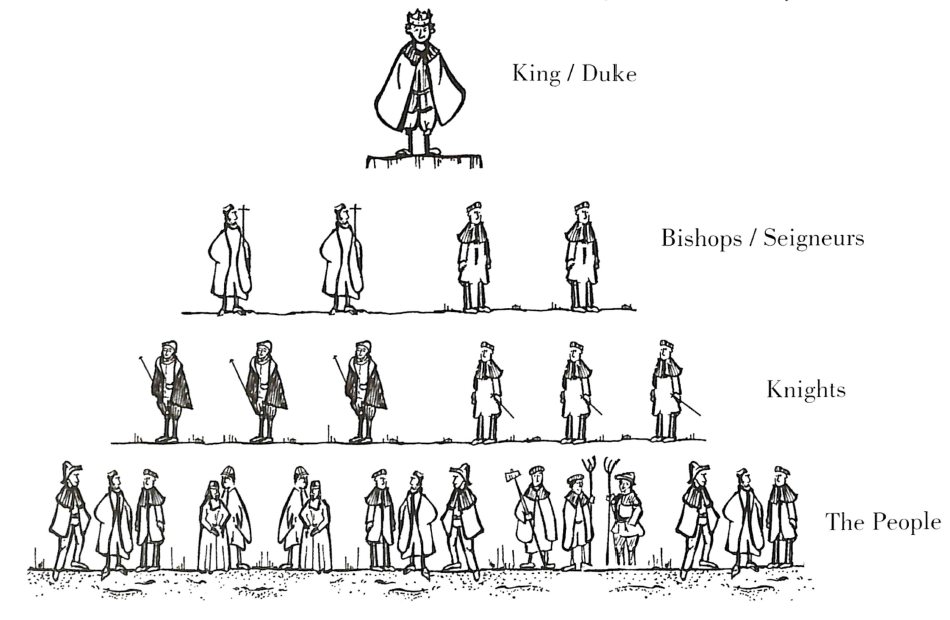
The Feudal System
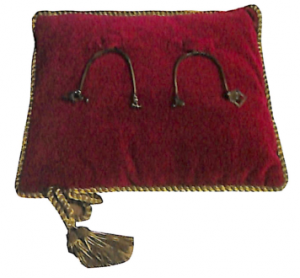 The Tenants benefited from the system as they received the military protection of the Seigneur’s armed men, and they enjoyed security of tenure so long as they paid their feudal dues. As coinage was almost unknown in rural areas, all dues were payable in kind. Land rent was payable in corn on St. Michael’s day at the end of September after the harvest, and house rent was paid in chickens (poulage), usually two chickens for each house per annum, to make up for the corn which could have been grown on the land occupied by the house. In addition, tithes were payable to the Church. Rents were often expressed in terms of spurs, e,g. silver spurs and gilt spurs. Other dues recorded on Guernsey fiefs were a cartload of ashes, a chaplet of roses thick “as a man’s arm”, and ten butter flies.
The Tenants benefited from the system as they received the military protection of the Seigneur’s armed men, and they enjoyed security of tenure so long as they paid their feudal dues. As coinage was almost unknown in rural areas, all dues were payable in kind. Land rent was payable in corn on St. Michael’s day at the end of September after the harvest, and house rent was paid in chickens (poulage), usually two chickens for each house per annum, to make up for the corn which could have been grown on the land occupied by the house. In addition, tithes were payable to the Church. Rents were often expressed in terms of spurs, e,g. silver spurs and gilt spurs. Other dues recorded on Guernsey fiefs were a cartload of ashes, a chaplet of roses thick “as a man’s arm”, and ten butter flies.
Dividing Up The Island
The earliest record of a grant of fiefs in Guernsey is dated 1020 when Duke Richard of Normandy made a roughly diagonal division of the island from N.E. to S.W., giving the south-eastern half containing the parishes of St. Sampson’s, St. Andrew’s, St. Peter Port, St. Martin’s and the Forest, to Néel, Vicomte of the Cotentin, while the remaining parishes in the western half of the island were allotted to the Vicomte of the Bessin. (The Clos du Valle—Vale Parish—at this period was an island and waste land). Part of the Vicomte of the Cotentin’s lands were, during his disgrace, given by William the Conqueror to religious foundations such as Caen, Coutances and the monastery of Ste. Helene near Omonville, which was associated with the great Abbey of Marmoutiers.
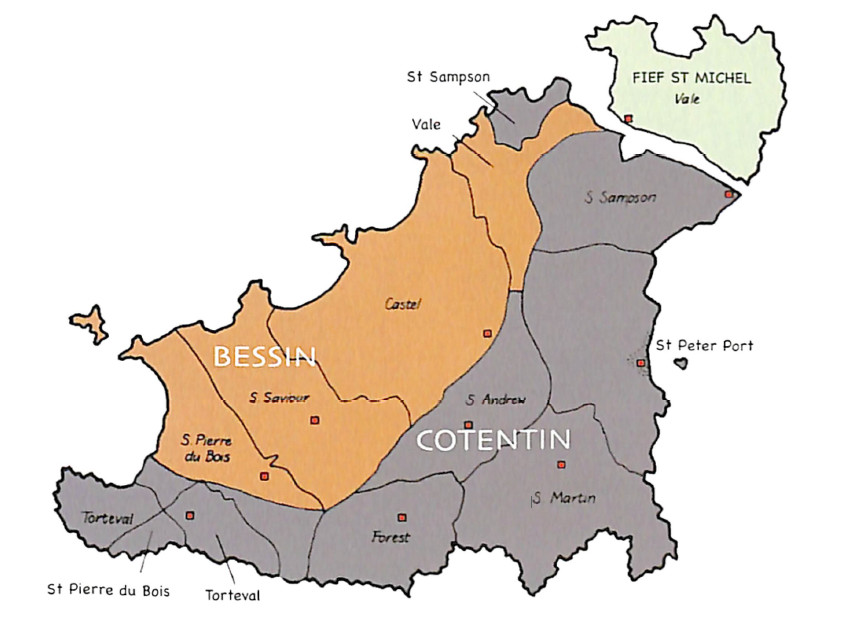
Land Holdings in Guernsey circa 1020
The Vicomtes in their turn delegated their duties to the lower grades of Knights on their Norman fiefs. Guernsey place-names such as Anneville derive from the Norman castles of these Seigneurs.
Some of the Norman Knights holding Guernsey fiefs accompanied Duke William on his conquest of England in 1066, and were rewarded with grants of fiefs in England. Over the next 150 years some of the fiefs changed hands as the Seigneur’s either backed the winners or losers in the strife that engulfed Normandy and England over the succession to the English throne in the 12th century.
Increase of population and agricultural expansion at this period brought much former waste-land into cultivation, and many new sub-fiefs came into being which bore the name of island families such as Grantes, Malmarchy (Mauxmarquis), Vaugrat, etc.
1204 And All That
The loss of Normandy by John in 1204 caused a conflict of loyalties among the Norman holders of the island fiefs who had to decide whether to pay homage to the French King or to John. In order to safeguard their Norman possessions many Seigneurs abandoned their island fiefs, and these were seized by the English Crown, and granted to island families such as Le Marchant, de Beauvoir, etc. The last major distribution of fiefs was brought about by the seizure of the property of Alien Priories by Henry V in 1413; this action resulted in the fiefs which had been granted to Norman Abbeys and Monasteries passing into the control of the Crown, which still holds them, and at the present time the Crown Receiver answers at the Court of Chief Pleas for the Abbess of Caen, the Bishop of Coutances, etc. The fief of the Abbey of Blanchelande was sold by the Crown to Nicholas Carey in the reign of Elizabeth I (1563).
Feudalism & Sark
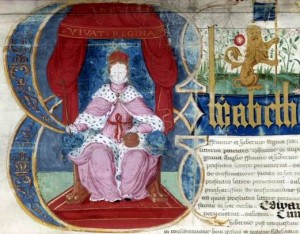 Elizabeth I’s reign saw a remarkable revival of the feudal system when in 1565 the Queen granted the Island of Sark as a Fief Haubert ( A fief or fee held by the tenure of knight-service) to Helier de Carteret, Seigneur of St. Ouen in Jersey, on condition that he maintained 40 men in the island for its defence. Helier fulfilled his liability by setting up 40 tenements, each with a holding of land sufficient to support a household, and with the liability of keeping in the house one man armed with a musket and ammunition for the defence of the island.
Elizabeth I’s reign saw a remarkable revival of the feudal system when in 1565 the Queen granted the Island of Sark as a Fief Haubert ( A fief or fee held by the tenure of knight-service) to Helier de Carteret, Seigneur of St. Ouen in Jersey, on condition that he maintained 40 men in the island for its defence. Helier fulfilled his liability by setting up 40 tenements, each with a holding of land sufficient to support a household, and with the liability of keeping in the house one man armed with a musket and ammunition for the defence of the island.
Fief Courts
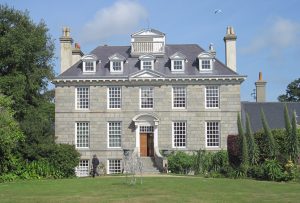 The Fiefs made a very important contribution to the maintenance of law and order in the island through the exercise of the judicial functions of the Fief Courts, at which attendance was compulsory for all tenants on penalty of a fine. The Tenants were also liable to provide the officers of the Court, which included a Seneschal, a Grangier or Greffier, a Prevot or Sergeant, and Vavasseurs. On the larger fiefs the Court assembled at a Court House such as the Fief de Sausmarez at Sausmarez Manor. The smaller fiefs met at some central point on the fief in the open air. The Courts settled all disputes and encroachments, and were responsible for the compilation of the “Livre de Perchage” which detailed the exact holdings of each Tenant. These Livres which were revised and brought up to date every 20 years constitute an unrivalled record of island family history.
The Fiefs made a very important contribution to the maintenance of law and order in the island through the exercise of the judicial functions of the Fief Courts, at which attendance was compulsory for all tenants on penalty of a fine. The Tenants were also liable to provide the officers of the Court, which included a Seneschal, a Grangier or Greffier, a Prevot or Sergeant, and Vavasseurs. On the larger fiefs the Court assembled at a Court House such as the Fief de Sausmarez at Sausmarez Manor. The smaller fiefs met at some central point on the fief in the open air. The Courts settled all disputes and encroachments, and were responsible for the compilation of the “Livre de Perchage” which detailed the exact holdings of each Tenant. These Livres which were revised and brought up to date every 20 years constitute an unrivalled record of island family history.
With improved communications and the establishment of the centralised authority of the Royal Court, and of the Greffe for the registration of contracts the importance of the Fief Courts gradually vanished away, and though dues are still payable on many fiefs, the Seigneurs have long since ceased to perform any useful function in return to their Tenants.






